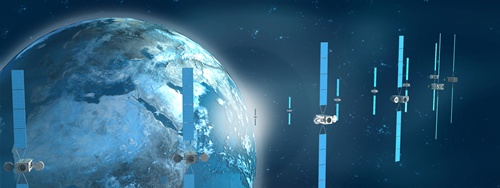The Space Environment
DID YOU KNOW?
Scientists at the University of Calgary in April 2009 determined that the edge of Space is 118km above the earth.
Space Weather and Security have been getting an increasing amount of media attention in recent years. ESOA participates in this dialogue as far as possible.
> ESOA speaks at European Commission's Space Weather Awareness Dialogue
> ESOA and its members actively participated in a Secure World Foundation event
Space is not a friendly environment for human beings. It is not a friendly environment for satellites either. This is why satellite manufacturers must simulate, as closely as possible, the environment and parameters that a satellite will possible experience during its lifetime.
Satellite electronics are designed to withstand the harsh environment up there, including radiation encountered in space, solar flare effects, extreme temperature differences of 250 degrees on the sun and shadow sides and so on. Satellites are designed and then tested on earth to make sure their components and redundancycan resist these extreme conditions in which they operate.
Solar Weather
Solar flares, vacuum or extreme temperatures are intrinsic aspects of the orbital environment, all of which satellites are designed to cope with. Margins taken in the design ensure protection of on-board equipment.

Even in the case of on-board equipment being affected by radiations or a solar flare, satellites are designed with built-in redundancy, which in the vast majority of cases enables them to bypass the problem and continue operation. With solar activity being cyclical, at 11 year periods, several cycles have already been experienced by satellites, without any major disruption to telecommunications or navigation services. There are currently about 300 active c ommercial communications satellites in geostationary orbit, only a small number have ever been affected by radiation-induced problems.
Navigation satellites (GPS today and Galileo in the future) are subjected to the same solar flares as geostationary telecommunications satellites. We have no record of any navigation satellite having been lost due to solar flares, but even in this unlikely event, it would have only a minor effect on the localisation performance from a user viewpoint – the overall system is designed to be redundant and robust so that service should not be disrupted by failures of this type.
Resilient Signals
Satellite signals are generally unaffected by events on earth such as earthquakes, floods, and so on. This resilience makes them the obvious solution for emergency communications and simple back-up for other - land based - communications.
ESOA was asked whether the volcanic ash of 2010 affected satellite signals. Satellite operators observed no disruption or reduction in the transmission of their satellite signals as a result of the Icelandic volcano eruption. The degree of dilution of the volcano ash once in the air was physically such that it could not possibly disturb satellite services.
In theory, an erupting volcano could affect all types of radio wave communication, as large quantities of volcanic ash can be electrically charged and could interfere with radio waves transmitted through the air. However, technical evaluations showed that the emitted fine dust and environmental micro particles were not ionized and were also poor electrical conductors. Therefore, the level of possible interference or disruptions was zero and no damage was caused to satellite signals or ground installations.
Space Debris
While ESOA members behave responsibly in launching, flying and retiring their spacecraft, space debris caused by numerous factors remains a serious issue, heightening the threat of collision and disruption of critical satellite services relied on by businesses, consumers and government users alike. Space debris can be the result of defunct satellites that have not been re-orbited to graveyard orbits or de-orbited so that they burn up when re-entering the earth's atmosphere, spent rocket stages or fragments resulting from rare collisions of out of control satellites for example. Even if rare, one collision can result in millions of pieces of debris that float through space. As the orbits of these objects often overlap the trajectories of spacecraft, debris is a potential collision risk.
Satellite operators such as those in ESOA generally carry sufficient reserve fuel on board their satellites so as to be able to intentionally fly their satellites into a so-called "graveyard orbit" at the end of their operational life. It is a responsible practice performed in order to lower the probability of collisions with operational spacecraft and of the generation of additional space debris.